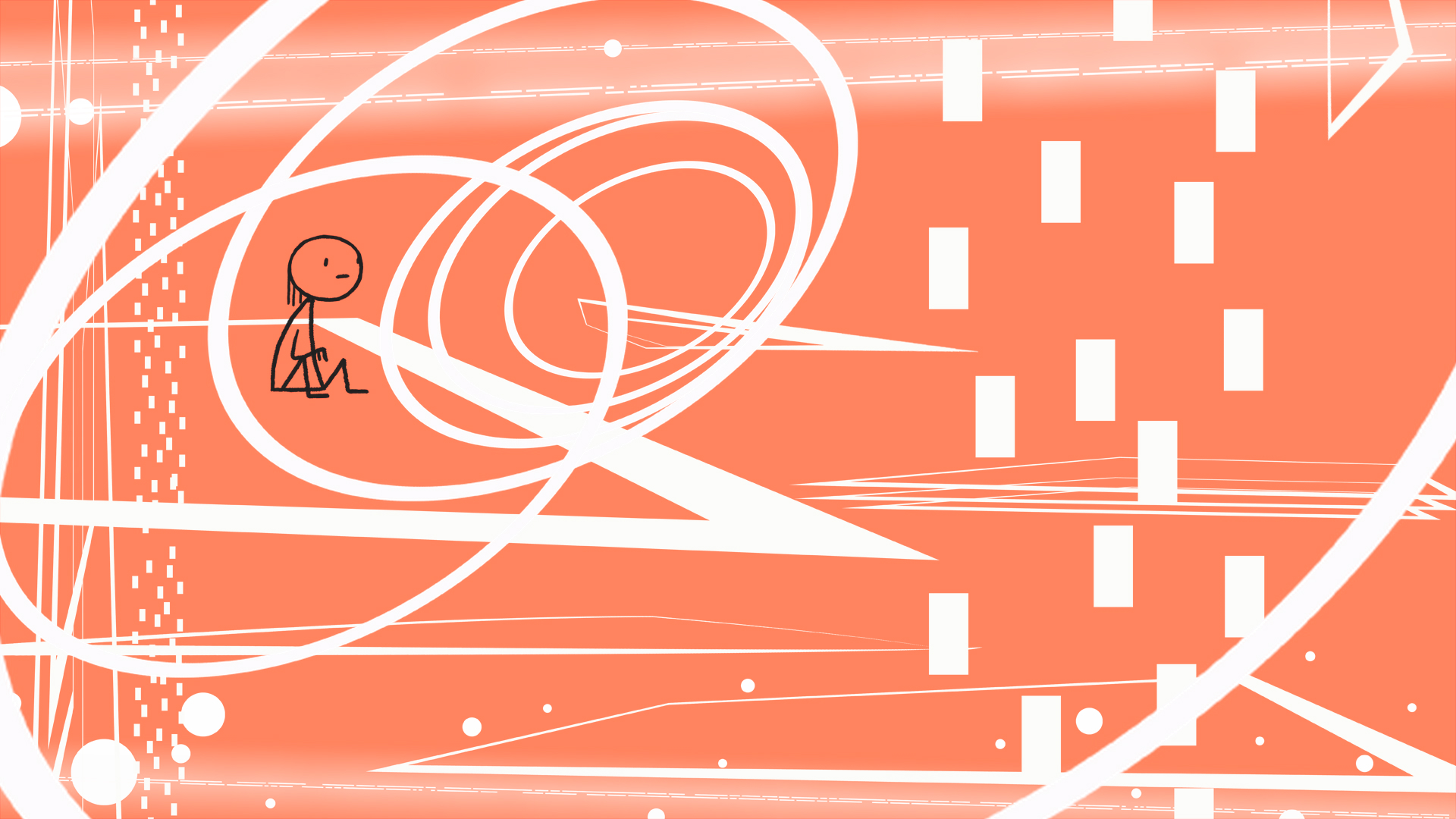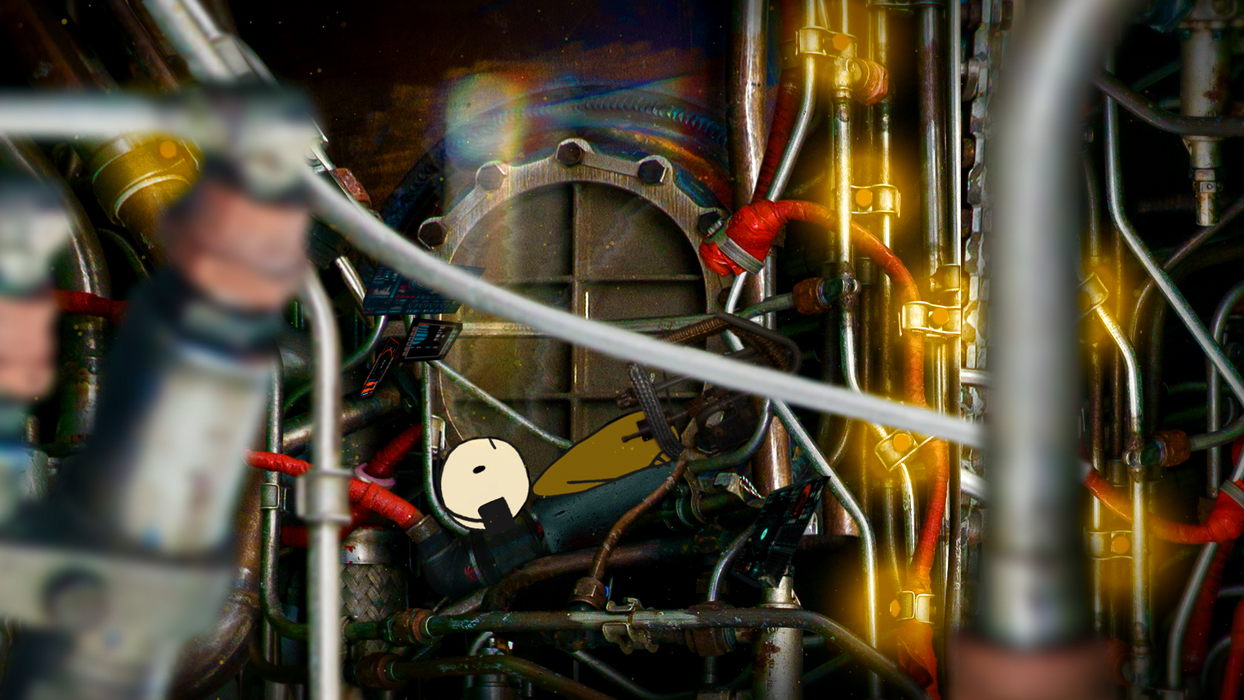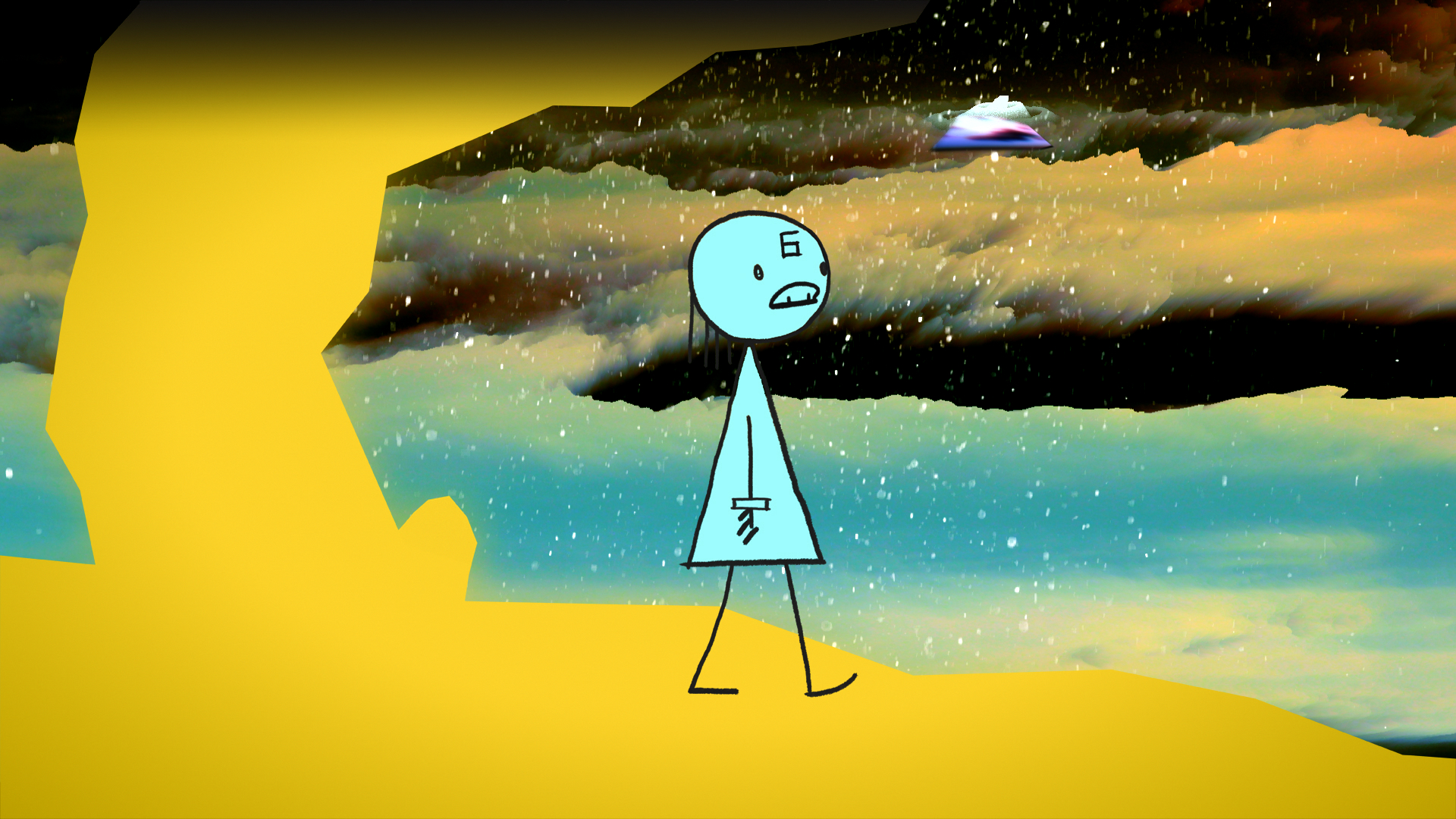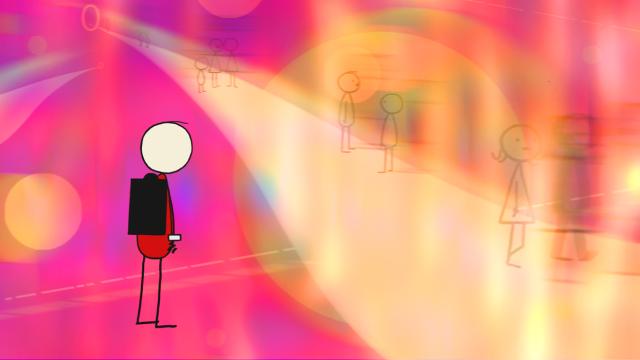Name the greatest sci-fi film franchises ever made. Star Wars. Star Trek. Aliens. Back to the Future. Planet of the Apes. There are others but it’s not a very long list. And yet, these days, any such list would almost certainly be incomplete without World of Tomorrow.
World of Tomorrow is an animated sci-fi short film series from filmmaker Don Hertzfeldt. In the broadest possible terms, it follows a young girl named Emily who, later in life, is cloned many times and has her clones visit her younger self through time travel. The clones tell Emily stories of the future while she reflects on the present and things veer toward the mind-blowingly profound while also being funny, scary, heartfelt, and everything in between. Hertzfeldt not only writes and directs the shorts, but animates them, edits them and more, all by himself. Each film is a staggering achievement, and he’s just getting started.
The first World of Tomorrow was nominated for the Best Animated Short Film Oscar in 2016 and, in the years since, has spawned two sequels, the most recent being World of Tomorrow Episode Three: The Absent Destinations of David Prime, which was released in late 2020. The problem is short films are so prevalent these days, even the best ones can very easily get overlooked. World of Tomorrow was on Netflix briefly a few years back but, for the most part, the main place one could see the series over the past five years was on Vimeo. That changes this year.
[referenced id=”1066779″ url=”https://gizmodo.com.au/2017/09/world-of-tomorrow-episode-two-is-a-mind-melting-must-see-animated-sequel/” thumb=”https://gizmodo.com.au/wp-content/uploads/2017/09/25/mo3ex0pwdymtfh7wrbbs-300×162.jpg” title=”World Of Tomorrow Episode Two Is A Mind-Melting, Must See Animated Sequel” excerpt=”If you’re reading this, you’ve probably seen Don Hertzfeldt’s World of Tomorrow and simply want to know if the sequel is good. Yes, it is. It’s very, very good. And I highly recommend to go into it totally blank other than the knowledge of the first film.”]
This year Hertzfeldt took to Kickstarter to give fans and non-fans alike something special: a Blu-ray of the World of Tomorrow series so far. With a goal of $US30,000 ($38,475) over the course of a month, Hertzfeldt gained $US200,000 ($256,500) in just the first day.
With only a few days to go until the March 11 concluding, the Kickstarter is now nearing $US400,000 ($513,000). It’s a testament to just how beloved and special Hertzfeldt’s series is, so Gizmodo decided to ask him a few questions about the Kickstarter, the franchise, and more. Below is our interview, which was conducted via email.
Germain Lussier, Gizmodo: Why did you decide to go to Kickstarter to release these films on Blu-ray?
Don Hertzfeldt: I’ve had a weird career. Everything I’ve done has been independent, with unpredictable distribution. There haven’t been any big grants, I’ve never had a side gig, and I’m not a secret oil baron. There’s just an audience that’s always been ready to show up and buy a ticket to the newest thing. I don’t know what I’ve done to deserve that but they’ve funded everything for over twenty years. People know that buying a DVD is going to help pay for the next movie and not someone’s yacht, and I think that kind of simplicity isn’t really common in the film industry. And because of that sort of one-on-one relationship, Kickstarter felt like a really natural fit. It gives me a chance to open up the storage boxes and offer fans a bunch of rare stuff to say thanks.
Gizmodo: How are you feeling about the tremendous response to the Kickstarter?
Hertzfeldt: Well, this audience has always been incredible. I feel a constant responsibility to not go make a bunch of garbage with everyone’s money.
Thanks to them, the films have performed well enough over the years that I can keep slugging forward indefinitely with new work, as long as I keep animating alone like this. The problem is, everything takes so long to make when I animate alone that I’ll probably never live long enough to finish it all. With a proper crew of animators, everything could be released much faster, but it’s always been something I could never expect to fund totally independently.
Finding a permanent streaming home with a normal budget has been the goal for a while, but it’s been a really awful last twelve months in the industry. I was in LA exactly a year ago meeting with networks and streamers and once covid-19 arrived, I had three distribution deals fall apart in a row for the World of Tomorrow series, from theatrical to streaming. It’s been genuinely depressing to watch happen, but what can you do? Episode Three came out in the worst year possible.
So the great response to the Kickstarter has also been underlining for me how weird and a little sad it’s been that a distributor hasn’t given World of Tomorrow a home yet, despite everyone’s efforts. It’s a very popular thing in a very strange position. So the big question right now is whether we stay completely independent or are able to find this bigger home for what’s next.
Gizmodo: Modern cinema has gotten audiences really invested in “Canon” filmmaking with all these stories that tie together. (Marvel, Star Wars, etc.) Do you see World of Tomorrow as that kind of story where it’ll all come together in the end and, if so, how do you go about keeping track of all of the timelines and stories you’ve created with the multiple Emilys and now Davids?
Hertzfeldt: It’s a great time to be a fan and argue about canon. When I was little I remember intense debates over whether the Ewok Adventures TV movies were canon. “Why are the Ewoks riding ponies now? Is that a witch?” These were incredibly important matters of the day for us. I’d be so proud if World of Tomorrow fans are someday arguing over whether the episode where I finally snapped and put everyone on ponies was canon or not.
The Marvel universe has been really interesting. I like a lot of what they’re doing but I also wonder what becomes of a story when it never seems to actually end. Because I have a feeling they’re going to keep making new Marvel and Star Wars things long after everyone living on the planet today is dead. You and I are never going to see how any of it wraps up because it will probably just keep going and going forever, like the comic books have for so many decades. And that seems to shift these things out of the realm of a traditional story and maybe into something else that we haven’t defined yet in cinema.

Endings are very important to me. Stories need endings. Without an ending, you’re just sort of juggling forever. And if you’re a big fan of the juggler, that’s really great. But I’m afraid of being a juggler who becomes so successful at his one trick that he’s never allowed to stop doing it.
World of Tomorrow will have a definite ending, though whether it all comes together in any good or meaningful way is a whole other thing.
While writing Episode Three I did draw up a helpful timeline of events on a white board to keep track of everything: where and when all the Davids and Emilys live, when important things were invented, who’s aware of what. I’ll probably need to get a bigger white board for what’s coming next. And if I do accidentally screw something up in the canon down the road, luckily science fiction provides a lot of “undo” options. The ponies were a false memory, everyone!
Gizmodo: Watching Episode 3 I had this theory that, maybe, everyone in the world is either an Emily or a David. Whether or not that’s true it made me wonder, have you read any theories about your series that are completely wrong but that you’ve really enjoyed?
Hertzfeldt: I’m a little afraid to go seeking those out because what if the theories are better than what I have planned?
Gizmodo: Do you have a set number of Episodes in your head of how long the series will go on or are you playing it by ear?
Hertzfeldt: There isn’t a set number of episodes yet and that may depend a lot on whether or not a distributor gets involved and has an opinion. But my guess, and it’s just a guess, is that there will be not more than ten.

Gizmodo: How long has each one of the films taken and, when you are done with one, are you instantly inspired to make another, or do you need to take a break? If you do take a break, when do you know it’s time to do another?
Hertzfeldt: Episode Three took around two years to make and I’m probably going to take a bit of a break now as I try to navigate what’s next. I’ve only taken one other long break in these last twenty-five years, which was after finished It’s Such a Beautiful Day and was totally exhausted. In the early years, I really couldn’t take a break ever, or I’d go broke. I’m not sure if that was a pun. But back then, with each cartoon paying for the next one, and each one taking at least many months to complete, I had no choice but to keep working. But it was also a lot of fun to keep at it. When you find yourself making cartoons for a living, there’s a constant feeling of getting away with something.
When I was young and studying my favourite filmmakers, I had this romantic idea that it’s just this life of constant creative wizardry with no breaks, from movie to movie. But then you learn that all these people spent most of their time not on a movie set doing what they love, but going from meeting to meeting, constantly pitching, hustling studios, raising money, and doing projects they don’t care about in order to get to the one that they do.
Outside of the industry, you’ll usually find no money but the most creative control. But I’ve been in the very strange position of having both creative control and constant funding — as long as I keep things reasonable. So in more recent years, every break I take between projects that lasts too long has come with this vague feeling that I’m squandering something very special.
Gizmodo: Do you have a timeline on when the next chapter could be coming?
Hertzfeldt: The next episodes could come out all at once if we find that home with a streamer. If not, I would guess another couple of years before we see Episode Four, as long as I don’t wander off to work on something else first. “Another couple of years,” isn’t that awful? I feel genuinely bad about that, knowing that people are going to be waiting around for it. Can you imagine if WandaVision was like, “Don’t forget to watch the season finale, two years from now.” And after all that, what if Episode Four isn’t even any good?
Gizmodo: Each episode is packed with so many different ideas, both the big ones at the centre of the story and little asides and visuals. Do you keep a running log of ideas or do you do them all in a big brainstorming session?
Hertzfeldt: I’ll keep a sort of running log in the form of piles of doodles and stray ideas written on Post-It notes, and at a certain point, all these notes feel like they reach a critical mass and I have enough material to start sticking things together and seeing what kind of story appears.
I’ll usually start animating at that early stage and keep rewriting through every phase of production. A lot of new material comes along after just seeing how everything looks on screen for the first time. The script is important, but it’s not until you start playing around with the images and sound that you can see where you’ve gone wrong and what needs to change.

Gizmodo: When did you know that Episode Three would be more about David than Emily?
Hertzfeldt: Before I started writing it, I knew I needed to focus on someone else and start to expand the universe. The first two episodes to me felt like we were just establishing the ground floor of a building. To keep moving upwards, especially looking past Episode Three, the series needed to really start to grow and get weird and not fall into any formulas. It’s boring to stack the same pieces on top of each other, over and over.
Gizmodo: Out of all three films, is there any moment of animation you are particularly proud of?
Hertzfeldt: There’s a little moment in Episode Two when the music swells and Emily briefly looks up before she starts dancing to The Nutcracker. I just really like how she looks up for her music cue before she goes into her dance. And the camera rushes forward at her, which I always thought of as sort of a Martin Scorsese kind of thing. I saw the shot again a little while ago for the first time in years and thought, “Hey, that was pretty good.”
Gizmodo: How often and deeply do you think about the mentality of these characters? For example, do you dig deep into what David would think when he’s visited by this Emily clone and is sent on this journey and how does that impact the movie?
Hertzfeldt: I don’t know if I dig deep, but I do have to relate to every character on some level in order to write for them and their motivations. And that carries all the way through to animating them, too. A basic animation lesson is to focus on whatever a character’s thinking in a scene, instead of just whatever action they happen to be doing. An animator has to think like an actor: “I’m drawing this person crossing the room, but how do they feel about crossing the room?” So I do have these characters in my head for a really long time.
Gizmodo: I was watching Soul recently and the Jerry characters reminded me of your characters. I asked Pete Docter about it and he acknowledged there was probably some influence. Do you see your influence in and around pop culture and what do you think when/if you do?
Hertzfeldt: I think that’s great. Pete is awesome. I feel like I’m usually pretty blind to seeing my stuff reflecting out there unless it’s like some egregious advertising steal. When Soul came out everyone was pointing out all these things that I don’t know I would have actually even noticed or considered. I think I sometimes tend to assume that nobody is watching my stuff ever. I might also just not be so well-versed in my own work anymore after I’m finished with it.

Gizmodo: In my opinion, Episode Three gets a little scarier than the other ones, which was unexpected but appreciated. Do you go into these with a specific tone in mind or does that come as a result of the story?
Hertzfeldt: The tone of a scene doesn’t develop until I’m getting into the sound work. Maybe I’ll think this scene could be ominous, this one could be hopeful, but when I roll up my sleeves and start playing with sound and something starts pulling a scene in a different direction, I’m usually happy to let it go there. If something ends up being scary when maybe I originally expected it to be nostalgic or something, then let it be scary. If I try to fight that, I will often end up with something lukewarm that’s just not particularly good in any direction.
I try to have the same approach with most creative decisions. It’s like walking a dog on a leash. You’re still guiding where the dog ends up, but let the dog go explore on its own a little at the end of that leash and feel stuff out. Maybe the dog might find something unexpected and cool. It’s OK to follow a blueprint, but you have to hang on to some sense of discovery about it because nobody wants to watch a blueprint.
Because it’s so expensive, animation production is often so rigid and calculated from A to Z that there’s not much room for discovery or change as you go. And that can often run the risk of sucking the air out of the screen and making things feel weirdly flat. You might just be left with this great-looking dog that obediently goes from over here to over there. With so much at stake, people can sometimes get reluctant to follow the unexpected things.
World of Tomorrow is anything but expected.
A big thanks to Don Hertzfeldt for taking the time to answer all of our questions. If you’d like to watch the World of Tomorrow films now, you can rent or buy them on Vimeo at this link.
If you’d like Blu-ray, head to Kickstarter, where there are tons of additional perks and additions you can choose, but only until March 11.
